Click Here for images and info about a Rickenbacker horseshoe pickup I have that will fit / work on this Steel. |
ll Page 1 of 1 ll Back to the Top ll |
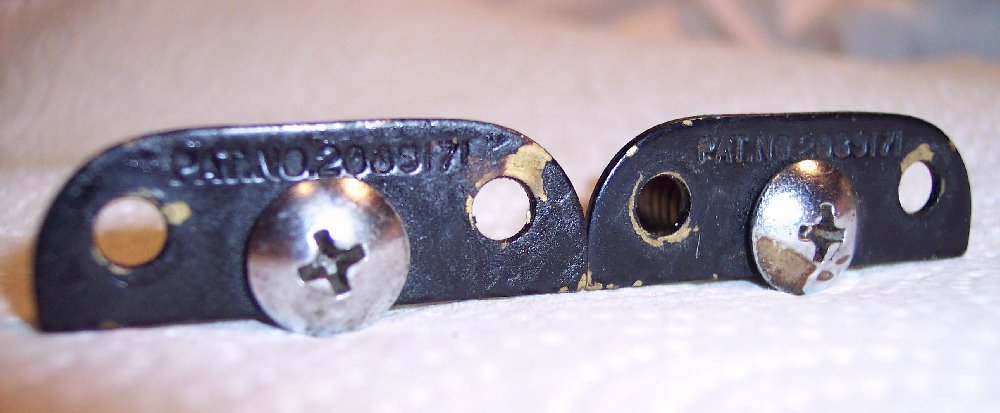
ll Page 1 of 1 ll |
Rickenbacher Model 59 Temporarily a basket case in line for my workbench refurbishment |

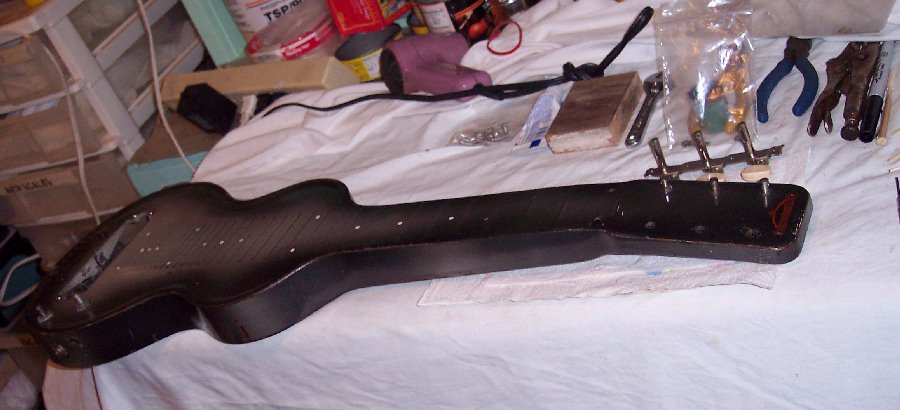
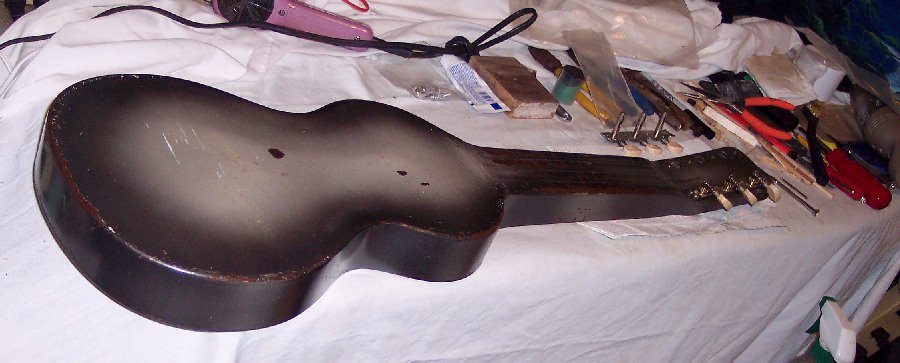
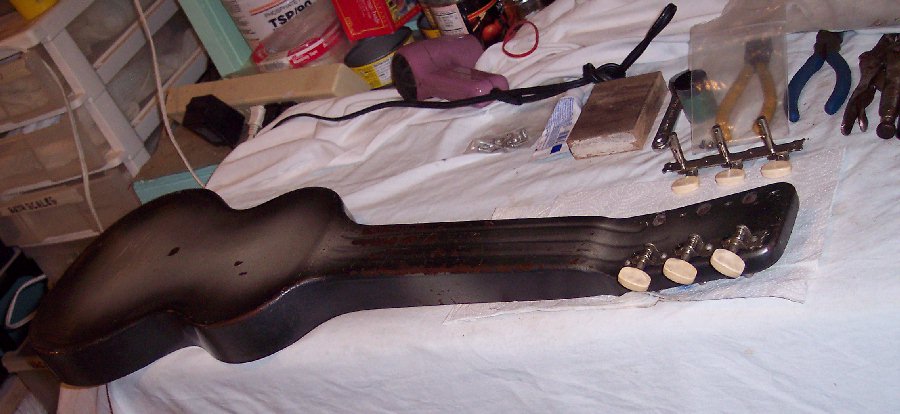
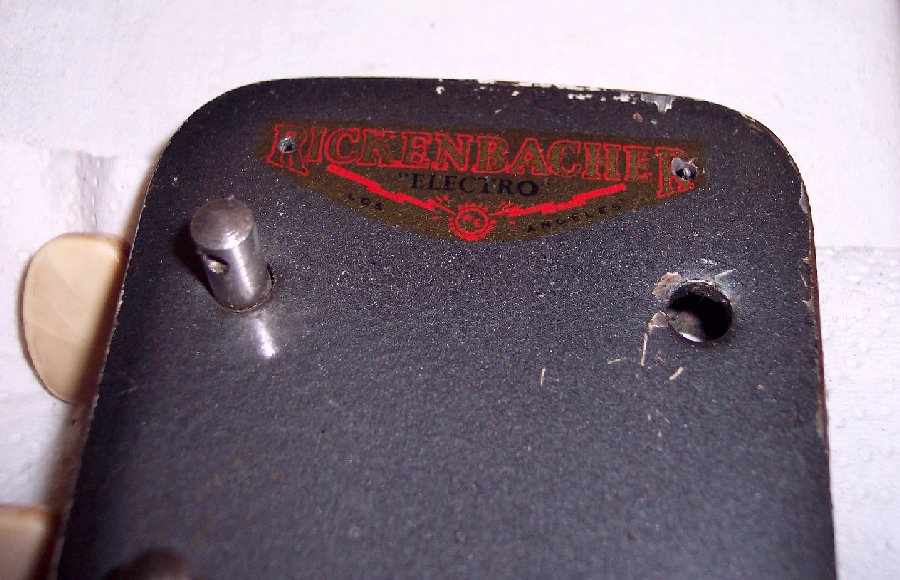
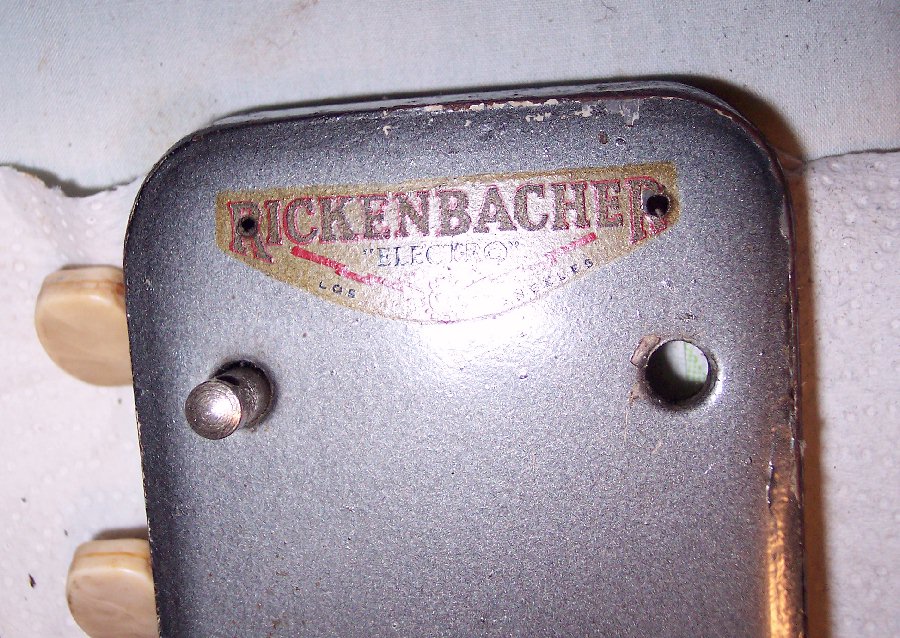
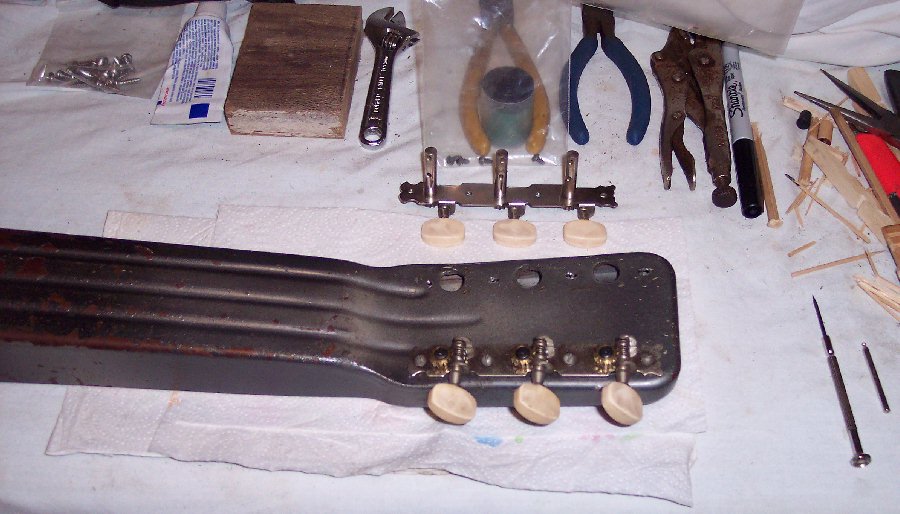
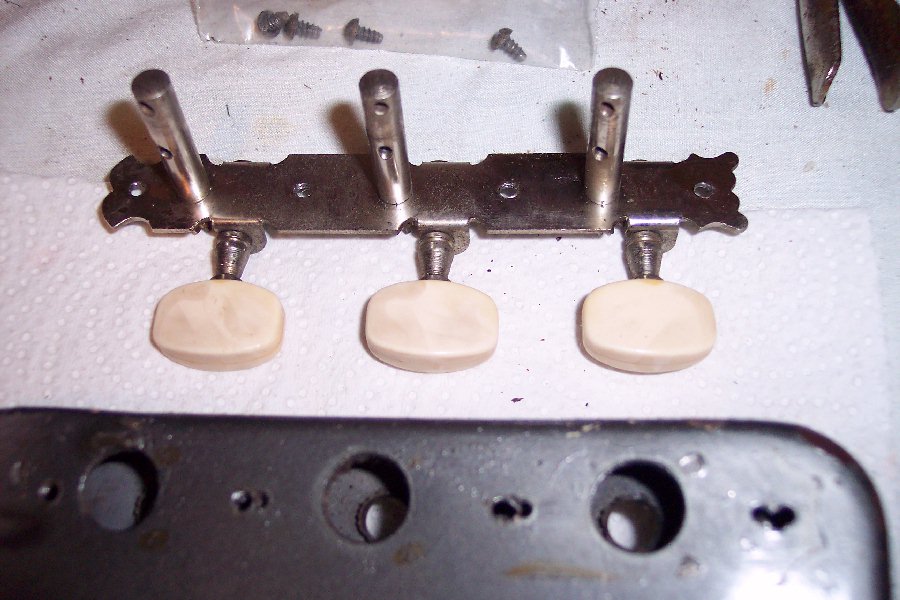

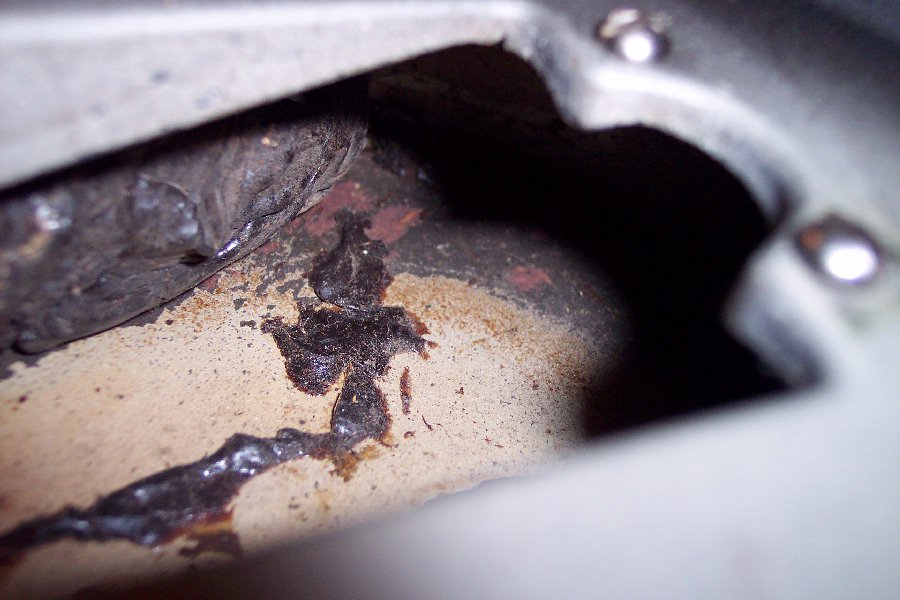
This is one of the old Rickenbachers famous for either their strong clean tones or raging tones under higher amp gains. It has a strong metallic resonance that is tamed to a Player's preference by how tightly the body is packed with a dampening medium; Crumpled newspaper was packed in at the factory, but a number of other materials such as towels and rolled thin rubber sheeting has also been used; Even sand was known to be used back in the heyday of Hawaiian Beach Music (and just might be the purpose of the mysterious tar packing of the wires and pots that is not uncommon to find ...such as this one). Old Ricks are THE icon to Wang Wang Blues yer hula girls' scruples away. These pictures were taken at the request of an inquirer, and were taken on my portable bench during a drying / curing time period for another guitar being worked on this bench; And thus why some tools and supplies are also on the bench while taking these pics. This is a Model 59 / NS stamped steel body with original bakelite bridge, nut and all screws. I had previously identified this body's year as 1937, but upon closer inspection I cannot be sure because (1) there are no serial numbers on the body itself and, (2) what I can see of the pots embedded in the "bakelite tar", they don't look like the larger pots of that period and, (3) the logo decal looks like it once had a similar metal emblem plate screwed over it and, (4) I still have to research the period that a decal headstock logo might provide an era period for the body and if there was a year for change-over to a metal plate logo and, (5) there is no way to yet know if the pickup mounting bracket with patent numbers are definitely original to the body or not (I will bet it is). This Steel is missing it's original pickup and potentiometer knobs. The tuners are not original. Rickenbacher used several different tuner sets over the years based upon what batches they acquired. There are faint marks of Kluson enclosed strip tuners in this Steel's original headstock paint. The parts this Steel needs to be playable (understatement !) are a pickup and volume / tone knobs. See remarks noted on certain pictures below: |
The fretboard clay dots are remarkably all still present and in good condition. Surface corrosion is about average for the average condition of 59 / NS models that exist today; Mainly along the back of the neck, and along the edges of the body where they took the most handling wear. There is the usual accelerated corrosion pitting around the strings' ball-end receiver sockets where hand sweat accumulated; That is a natural balanced lifting point for the guitar and the spot that string vibration would drive right-hand playing sweat to. Chipping of the brittle paint finish is also about average for average condition models 59 / NS. Paint chipping and surface corrosion go hand-in-hand on these Steels; Hand sweat and atmospheric moisture enters under the paint anywhere the paint got chipped along it's life, releasing the paint's adherence and expanding the tiniest of chips to flake off slightly larger than the original chip. See my notes at the bottom of this page about Polyurethane paints that later became a popular industry standard in the mid 1960's and a consideration for refinishing or clear coating this and similar guitars. |
Why there are logo plate holes over the decal is a mystery to me, ...although I am guessing that this body had the decal on it at a time when Rickenbacher decided to apply metal logo emblems. The logo decal would be in excellent condition were it not for the holes drilled through it. These holes can be filled with epoxy and the logo design repainted over the patch by a talented sign / bulletin artist. |
These are universal / generic tuners as evidenced by the 2 holes drilled into the string shafts. They are of the J hook shaft boss type and are of average good quality chromed steel materials. They are mechanically / properly tight. Their tuner buttons are intact, strong with normal finger staining. Corrosion is limited to quite nominal / minor surfacte pitting. |
The Mysterious Tar in Some Rickenbacher Model 59's / NS: I have yet to encounter a definitive definition or qualified opinion of what the mysterious "tar" is that pots a number of old Rickenbacher steels, nor what the purpose of it is. My SWAG (scientific wild ass guess) is that the tar is a bakelite based tar that coud be poured and would later harden. It is brittle and looks every bit like bakelite. My guess is that the extreme delicacy of the pickup winding lead soldered to the pickup-lead solder point on the bottom of the horseshoe pickups, got whacked by loose wires enough times for players to have learned this trick to seal the wires off from such movement. It could also be because these guitars were stuffed with newspaper at the factory to tame their metallic resonance, and thus the wires were potted to protect them from the stuffing pressure. It could also be that the wires themselves could induce some microphonics in the pickup's strong magnetic field associated with the metal body. ~~~~~~~ In any event, should it be desired to remove the tar, it is quite brittle and would come right out by tapping it with a small chisel; And once enough of it were chipped from around the potentiomters, they would lift out through the pickup hole where the remaining tar could be removed from the pots as well. ~~~~~~~ Although I played this Steel before disassembling it for a refurbishment ( interrupted by a forced medical retirement several years ago and an extremely full plate preventing getting back on this project since), the pickup lead wires now read 250K between them in all positions of the volume and tone pot, which shouldn't be (should read 0 to 500K across the volume pot operational range while not noticing any resistance differential through the tone pot and capacitors path to ground). The pickup ground lead reads a solid / proper communication with ground. The first pic below is looking in at the pots; At the best I could get the camera lens into. |
A view into the bass bout side where the tar tapers off. I am guessing that it would take about 2 hours to get this stuff chipped out in a manner that would not damage the pots; With about 30 minutes to get close to the pots and then another hour and a half to be more surgical around the pots. |
ll Page 1 of 1 ll Back to the Top ll |
THIS PAGE UNDER CONSTRUCTION |
NOTES: Polyurethane paints became very popular for metal surfaces in the mid 1960's automotive industry, because polyurethane is rubbery and very flexible and resilient and far less prone to chip. Guitars along with many other industries followed suit. Were I to refinish this Steel AS A PLAYER, or even clear coat it's original existing finish, I would use polyurethane. Besides being highly resilient, it would also help tame the strong metallic resonance these Steels are famous for and were packed with newspaper at the factory to help tame ... (I find rolled-up thin rubber sheeting works very good). High quality polyurethane paint is a 2 part paint and requires experience to spray it. Any reputable car paint shop has expert experience spraying polyurethane, and are usually remarkably affordable to get an expert spray job done. Reputable custom car / motorcyle paint shops can even do expert graphics if desired. One of the coolest model 59 / NS Steel non-original finishes I've seen was painted hot-rod flat black with old-school hot-rod flames! Stenciled old art-deco designs and airbrushed graphics also look great on these Steels. If I wind up redoing this Steel, I would lean heavily on a baby blue polyurethane with either subtle graphics or faint flames! |
Click Here for images and info about a Rickenbacker horseshoe pickup I have that will fit / work on this Steel. |


Bottoms of bridge and nut. |
Tops of bridge and nut.. These parts are in Near Mint condition; My camera and flash gain simply refuses to lock in on these parts. |
Pickup mounting brackets. Includes original side screws (not shown) for the empty holes here: |